
CUSTARD APPLES IN THE TROPICS
SCIENTIFIC NAME: Annona sp.
FAMILY: Annonaceae
This article is about may own experience growing custard apples in Cairns. Hopefully it may be of some practical use to our members.
The Problem
I originally bought some trees of Gefner (an Atemoya hybrid) grafted onto Mexican Soncoya (Annona purpurea) rootstock which I was assured was a good stock for wet tropic conditions on the coastal areas of Far North Queensland. Gefner does better on the coast than other varieties.
However, unfortunately, this rootstock turned out to be Bullocks Heart (Annona reticulata). All trees subsequently died due to infection with Bacterial Wilt (Pseudomonas solanacearum), a common disease of custard apples which is prevalent in my garden. The symptoms fitted perfectly the description and illustrations in that excellent book on custard apples by the Queensland DPI. Infection could perhaps have been aggravated by the heavy summer rainfall in this area and frequently waterlogging, driving torrential downpours, weakening the trees.
Also, according to Sturrock's Fruits for Southern California, page 69, the Bullocks Heart root system tends to develop unevenly and trees topple over in windy conditions, and we get cyclones! It has a rather shallow root system which is another disadvantage for our conditions up here.
Thus, it would appear the Bullocks Heart is totally unsuitable as a rootstock for Atemoya varieties under our conditions and has proved beyond doubt to be highly susceptible to Bacterial Wilt.
The Solution?
Be that as it may, I decided to persist with growing custard apples in my garden.
Having researched all available literature and phoned for advice from the D.P.I., it would appear that the Pond Apple (Annona glabra) would be a more suitable rootstock. This species is tolerant of wet feet as it grows in the Florida swamps, apparently. Whether it is resistant to Bacterial Wilt is another matter. Nobody could confirm this, but I decided to try it out anyway.
Compatibility was the next problem. Atemoya hybrids such as Gefner are not compatible with Pond Apple. However, Bullocks Heart is compatible with both so I have used Bullocks Heart as an interstock.
This is contrary to the compatibility chart on Page 26 in the D.P.I. book where it is indicated that Atemoya is not compatible with Atemoya reticulata. All I can say is that it seems to work with the strain of Bullocks Heart we have here. I have seen mature trees of this combination growing and cropping well in a well-drained and apparently wilt-free site on the Tableland.
According to Popenoe, Page 188, Bullocks Heart is compatible with Pond Apple so double grafting with these species should be totally compatible.
In the D.P.l. compatibility chart, both the parents of Atemoya hybrids, Atemoya cherimola or Atemoya squamosa are compatible with Atemoya reticulata, so why is the resulting hybrid indicated as not compatible? Practical experience does not seem to bear this out. I would be interested to hear other peoples' opinions on this. A reply to this article in the "The Exotics" would be most helpful. Perhaps suggestions for alternative interstock species could be included.
Delayed Incompatibility?
This could well be a problem later on. Time will tell. An example of delayed incompatibility is well illustrated on Page 24 of the D.P.I. book where Cherimoya was used as an interstock between Pond Apple and African Pride. Growth was weak and most of the trees died before they were five (5) years old.
My tree is now into its third year and has grown extremely vigorously right from planting. Graft unions appear smooth, with the Pond Apple rootstock being slightly thicker than the Bullocks Heart interstock. So far so good.
1998-99 A Testing Time
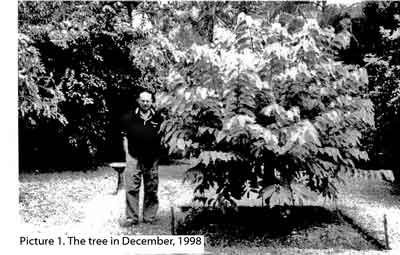
My tree is planted where five of the original trees died from Bacterial Wilt infection. So, as the soil is heavily infected with the bacteria, this should be a good test for wilt resistance.
We have just had Cyclone 'Rona' followed by heavy monsoonal rains. Days and days of torrential rain and severe waterlogging have been a good test for resistance to 'wet feet' and we have had exceptionally wet weather since then as well.
The tree pushed out a lot of fresh growth on the branch ends, which may indicate it has come through alright. My previous trees never grew as vigorously as this one.
Propagation - How Long Did It Take?
The short answer is too long! From the winter of 1995 to planting the above tree on 9.2.97. Double grafting takes a long time. I propagated several trees originally. One grew very well and was the first to take all the grafts. I put this down to the vigour of the rootstock. All grafting was done using green wood material at peak vigour.
The Rootstock
The Pond Apple is classed as a noxious weed up here by the D.P.I. and there is a concerted campaign to get rid of it. I got my rootstock in mid-1995 as seedlings coming up around a tree in the Flecker Botanic Gardens in Cairns (don't panic, its been pulled out long ago).
The seedling were started in 75-mm pots and potted on to 130-mm and finally into 200-mm pots, culling out the weakest growers at each stage.
The potting mix was just sieved garden compost plus an NPK fertilizer comprised of Blood and Bone, Super, Sulphate of Potash and trace elements. Side dressings of soluble fertilizer were applied regularly to maintain vigour for grafting. When grafting, side dressings are most important for both stock and scion to keep the cambium active.
The Interstock
Before my first lot of trees died the Bullocks Heart were grafted on, and threw some water shoots below the graft. These I cut off and cleft grafted the green terminal shoots into the tops of the Pond Apple seedlings covering the grafts with. plastic bags. This was done on 22.2.96. All grafted trees were raised in my patio which is roofed with green corrugated alsynite and shade cloth.
The Gefner Scion Variety
Once the Bullocks Heart interstocks were growing vigorously I cleft grafted them with green shoots from the remaining Gefner trees which were stall alive on 12.11.96.
The best tree was then planted on 9.2.97, once the shoots had hardened off. This is the tree in Picture No. 1. By this time the earlier bought trees had all died and were pulled out.
There were three Gefner grafts on this tree, which produced three long shoots. These were cut back at planting to about half their length and the end two leaves removed to encourage shoots to form the beginnings of scaffold limbs.
The tree was planted with NPK fertilizer plus trace elements and kept watered and side dressed as required to maintain maximum growth in the first year. A thick mulch of garden compost is maintained year round.
In July, 1998, the tree was shape pruned to develop secondary limbs and all flowers removed to encourage maximum growth. Two leaves were removed at branch ends to encourage rapid bud burst.
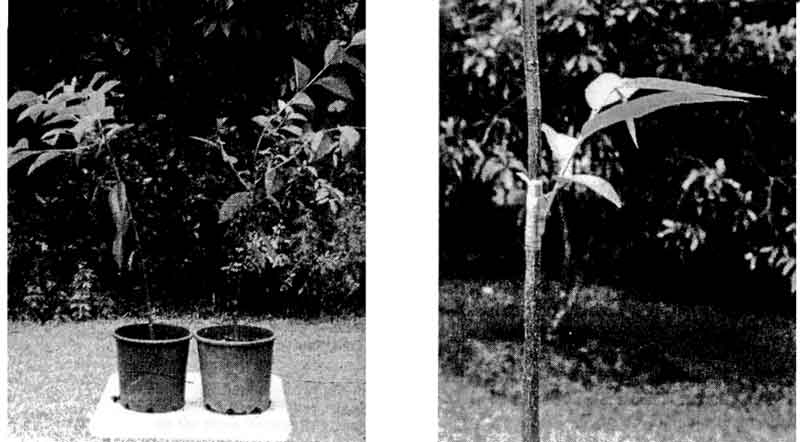 | |
| Picture 2. Pond Apple rootstock ready for chip budding. | Pic. 3. Bullocks Heart shoot on a Pond Apple rootstock. |
Keep the rootstocks fed each week with a balanced soluble fertilizer such as Aquasol or Thrive, etc., to encourage vigorous growth from the chip buds.
On no account remove the tape from around the chip buds. This can be left on until winter once the tree has been planted and staked. The budding tape expands as the graft grows, and deteriorates in sunlight anyway.
Approach Grafting
The next step was to green wood approach graft the Bullocks Heart interstock shoots onto the Gefner tree planted on 9.2.97.
I found that the Bullocks Heart shoots must be at least eight leaves or more in length to allow sufficient length and thickness of shoot before approach grafting can be accomplished. This took about three months.
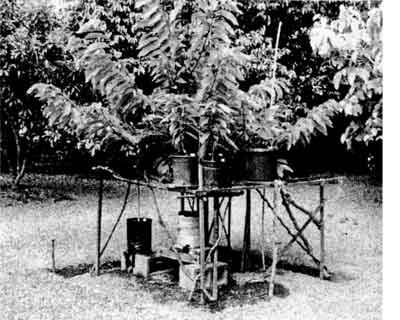
A gantry had to be erected around the Gefner tree on which to stand the potted plants, so as to position the Bullocks Heart shoots close to the Gefner shoots for ease of approach grafting.
It must be emphasised that all shoots must be growing vigorously and the whole operation timed to allow plenty of growing time left before dormancy sets in to allow the graft shoots to unite properly. I found that this did not always happen. A few late-grafted shoots of Gefner, although appearing to unite, must have only just callused without the xylem and phloem conducting tissues fully joining up. The Gefner and Bullocks Heart wood, although appearing healthy, died right back to the Pond Apple rootstock after the trees were detached and planted out.
However, the ones that were grafted earlier established successfully after planting. These were on the more vigorous rootstocks.
Picture 4 Gantry erected around the parent tree for holding
the potted plants in position for approach grafting.
For the gantry I found tomato stakes and scrap wood strong enough to hold the pots in place. To maintain vigour so essential for the grafts to unite quickly, both the pots and the parent tree must be fertilized regularly. Two teaspoonfuls of soluble fertilizer spread on the surface of a 200-mm pot and watered in each week does wonders. Water the pots first, then apply the fertilizer, watering this in sufficiently to get it into the root system but not out the bottom of the pot. Fertilize the parent tree regularly with a complete NPK fertilizer plus trace elements to maintain growth. Control fruit and Banana Spotting bugs as they can devastate young shoots, which set the grafts back weeks.
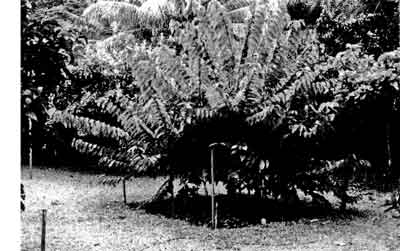
Cyclone Proofing
Four other trees have been planted out around the main centre tree and their shoots approach grafted onto its side branches. Once these are fully established, hopefully, this should give stability to the main tree in times of cyclonic winds. Time will tell.
The following picture shows the tree after completing much of its summer growth in March, 1999. The butt diameter 30 cm from the ground is 132 mm (5.25 inches) It is now just over two years old from planting, four years from the start of propagation.
![]() Picture 5. The tree in March, 1999.
Picture 5. The tree in March, 1999.
Propagation - A Short Cut?
If a Pond Apple rootstock is required, then double grafting is necessary for compatibility reasons with Atemoya varieties as described above.
Propagation took me two years, but can the process be shortened? I think it can. I have never tried this but I would suggest the following procedure:
Raise Pond Apple and Gefner plants from cuttings in a propagation frame and Bullocks Heart from seedlings (this cannot be grown from cuttings). Gefner, or whatever variety, to be raised from semi-hardwood cuttings just before bud break, as described in the D.P.I. book, Pond Apple to be raised from tip cuttings as described later.
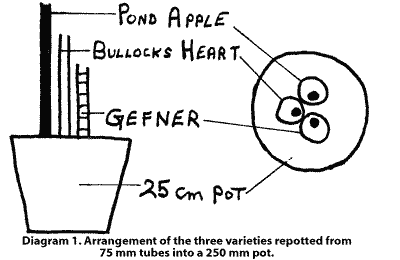
All three to be raised initially in small 75 mm tubes or 'Easyout' root trainers. When potting up the rooted cuttings and seedlings, be sure to place each of them so that they are against the side of the tube. Not in the centre.
Once they are established and require potting on, place each of the three in a 250 mm pot so that their stems are all as close together as possible. This will be easier if at first they were originally raised against the sides of the 75 mm tubes or root trainers. See Diagram 1.
Being planted close together as in the above diagram will make it easier to approach graft the Bullocks Heart to the Pond Apple and the Gefner, or other Atemoya variety, to the Bullocks Heart all at the same time in the one operation. This can be done once the three plants are well-developed with stems of around pencil thickness.
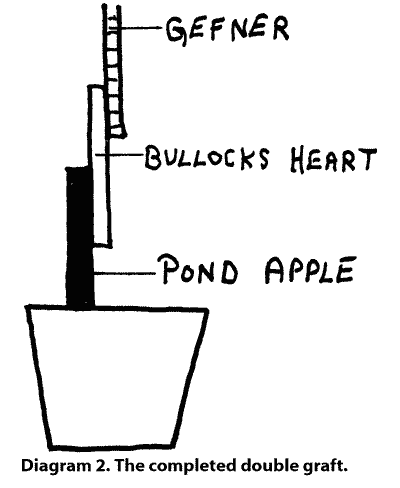
Once the grafts have taken and are well joined together, cut through the stems of the Bullocks Heart and Gefner below the grafts, thus isolating them from their own roots and leaving them on the Pond Apple rootstock. Remove the Pond Apple and Bullocks heart tops above the grafts. The remaining Gefner shoot should now grow away vigorously supported by the rootstock as per Diagram 2.
Grow on in the 250 mm pots in a nursery until the Gefner, or whatever variety, is well-established on the rootstock, and plant out the following winter.
This procedure is just a suggestion. It might not work, but it could be worth trying as it cuts out a whole year in the nursery.
The following are some observations I've made which may be of interest and some unknowns:
Pond Apple Rootstock
It is essential horticultural practice and will always result in more even tree development in commercial orchards if a Pond Apple CLONE (a selected seedling) of the required vigour is identified first and then vegetatively propagated from cuttings. The growth of seedlings is tremendously variable in Pond Apple and cannot be relied on. Graft failure is far more prevalent with seedlings. The weaker the seedling the more likelihood of graft failure.
I have found the best plants are raised from cuttings taken from the growing tips of the shoots (not nodal cuttings) from a selected vigorous grown seedling. Commercially this would necessitate growing stock plants of the clonal rootstock kept hard pruned to produce vigorous vegetative shoots and not allowed to flower. Cuttings from strong terminal growth, root and grow quickly in a propagation frame using Perlite as the rooting medium and once grafted are quick to take the graft resulting in stronger growth both from the interstock and the scion variety.
In my years of experience, trees on clonal rootstocks are far more responsive to irrigation and fertilizing than on seedling stocks of variable vigour and I have no reason to believe that Custard Apples are any different.
I would strongly suggest that in areas of poorer soil, a selected Pond Apple clone would give better results than seedlings.
Would Pond Apple give better anchorage with its stronger root system in wind prone areas? Don't know. Is it resistant to Bacterial Wilt? Time will tell.
Bullocks Heart Interstock
The Bullocks Heart I used were seedlings from one particular tree. I don't know whether there are variations in graft compatibility or perhaps complete incompatibility depending on the provenance of the seedlings
From my limited experience so far, the graft unions with Gefner look good with no signs of incompatibility. I also don't know whether seedlings of variable vigour would affect scion growth. My observation is that it is the rootstock that controls vigour, not the interstock.
Another unknown is the effect of varying lengths of rootstock and interstock stems on scion variety vigour. Would other Atemoya varieties behave differently with this graft combination?
In Conclusion
Whether double grafting using the above combination of species is ultimately going to result in a high-yielding, regular-cropping tree without incompatibility problems remains to be seen. But I think it is worth trying, all the same, for the sake of being able to grow custard apples down here on the coast of far North Queensland. Custard Apples are somewhat rare in backyards around Cairns due to the vagaries of our weather and high incidence of Bacterial Wilt.
So, if anybody has similar problems to us in far North Queensland and wants to have a go at double grafting, I hope this article will be of some help and I wish them the best of luck!!
DATE: May 1999
* * * * * * * * * * * * *
